Frijoles Volteados: The Ultimate Guide to Guatemala's Favorite Refried Black Beans
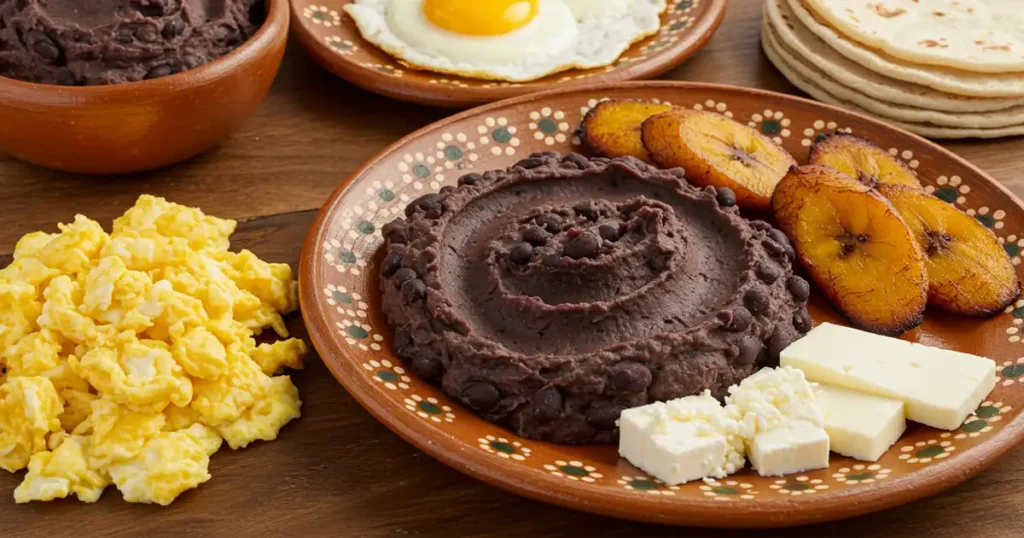
Guatemalan cuisine, a vibrant tapestry woven with threads of ancient Mayan traditions and Spanish colonial influences, boasts a rich array of flavors, textures, and aromas. Among its most beloved and ubiquitous dishes are frijoles volteados, a deceptively simple yet incredibly flavorful preparation of refried black beans.
More than just a side dish, frijoles volteados are a cornerstone of the Guatemalan diet, gracing breakfast tables, accompanying hearty lunches, and completing satisfying dinners. Their smooth, rich texture and deep, earthy flavor have made them an indispensable part of the nation's culinary identity.
This article delves into the world of frijoles volteados, exploring their origins, cultural significance, preparation, and the many ways they are enjoyed. Join us on this flavorful journey to understand why these "turned" beans hold such a special place in the heart of Guatemala and on the plates of its people.
What Exactly Are Frijoles Volteados?
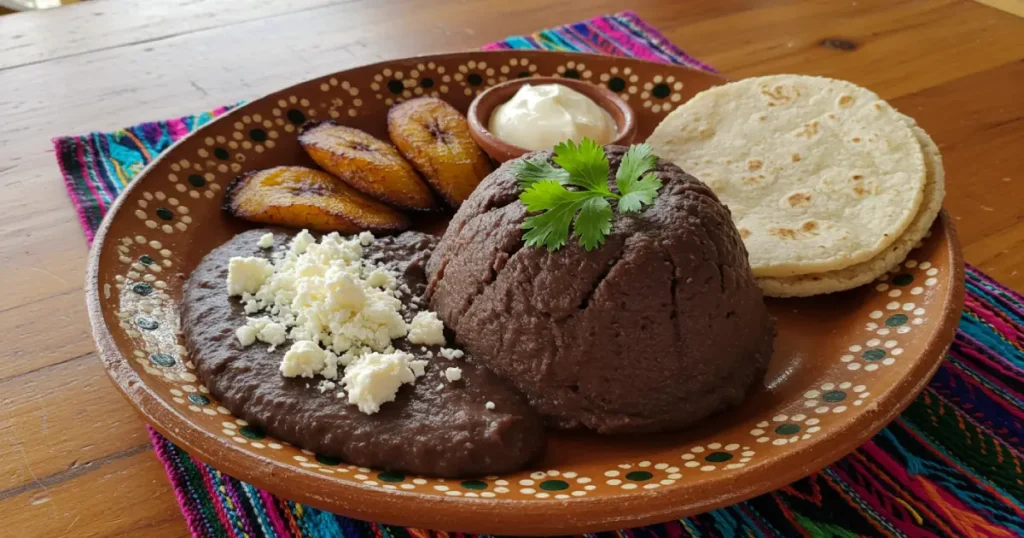
At its core, frijoles volteados translates to "turned-over beans" or "flipped beans." The name refers to the final stage of their preparation, where the pureed and thickened beans are often cooked until they can be "turned" or molded, sometimes holding their shape almost like a thick paste or even a sliceable loaf, especially when cooled. Unlike some other refried bean preparations that might be looser or more "soupy," traditional Guatemalan frijoles volteados are prized for their dense, smooth, and almost spreadable consistency.
Black beans are the star of this dish. While other beans are consumed in Guatemala, black beans (Phaseolusvulgaris) are the preferred choice for frijoles volteados, lending them their characteristic dark color and distinct, slightly sweet and earthy flavor profile.
The Meaning Behind the Name "Volteados"
The term "volteados" is quite descriptive of the cooking process and desired final texture. After the initial cooking and mashing or blending of the beans, they are refried, often with aromatics like onion and garlic, in oil or sometimes lard (manteca). The cooking continues, with constant stirring, until a significant amount of moisture has evaporated. This process thickens the bean paste considerably.
In some traditional preparations, especially when a larger batch is made, the beans become so thick that they can be almost "flipped" or "turned" in the pan as a whole mass. When cooled, they can often be sliced or molded. Even when served hot and slightly softer, the ideal consistency is one that holds its shape on a spoon or a tortilla, rather than running.
Key Ingredients
While variations exist, the fundamental ingredients for authentic frijoles volteados are remarkably few, highlighting the quality of the beans themselves:
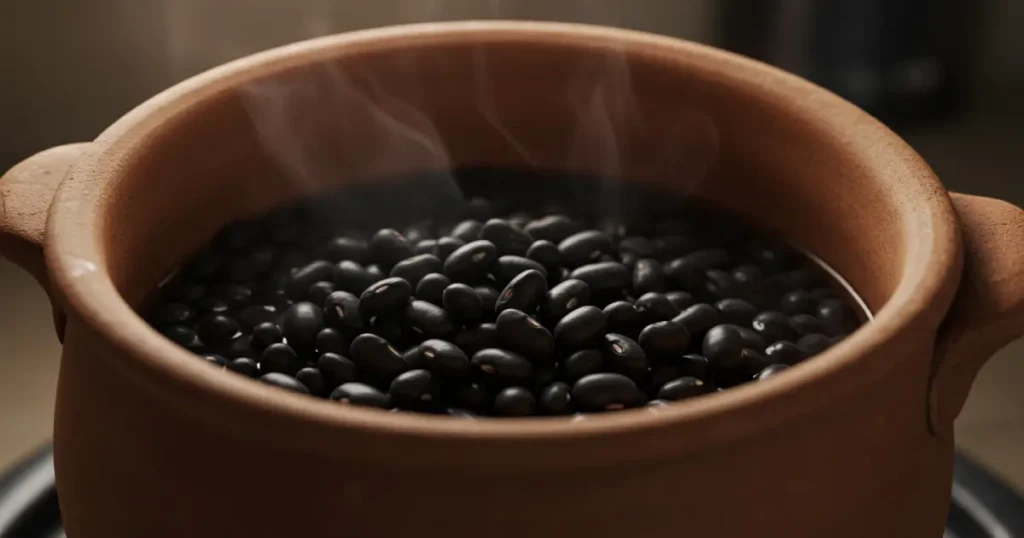
- Black Beans: The heart and soul of the dish. Dried black beans are traditionally soaked and then cooked until tender. Canned black beans can be used as a shortcut, though die-hard traditionalists prefer starting from dried beans for optimal flavor and texture.
- Aromatics: Onion and garlic are almost always used to build a flavor base. These are typically finely chopped or minced and sautéed before the beans are added.
- Fat: Lard (manteca de cerdo) was traditionally used for frying and adds a distinct richness. Vegetable oil is a common modern alternative.
- Salt: Essential for seasoning.
- Water or Bean Broth: The liquid from cooking the beans (or from the can) is often used to help in the blending process and to adjust the initial consistency before the final thickening.
Some recipes might include a hint of spice, like a mild chili, or herbs like epazote (though less common in the classic "volteados" form compared to "frijoles de la olla" or soupy beans). However, the beauty of frijoles volteados often lies in their straightforward, bean-forward flavor.
The Rich History and Cultural Significance of Frijoles Volteados
Beans have been a dietary staple in Mesoamerica for millennia, long before the arrival of Europeans. Guatemala, as part of this ancient cultural sphere, has a deep-rooted connection to this humble legume.
Mayan Roots and Evolution
Archaeological evidence suggests that beans were cultivated in Mesoamerica as early as 7000 B.C. For the ancient Maya civilization, which flourished in what is now Guatemala, beans, alongside maize (corn) and squash, formed the "three sisters" – a triumvirate of agricultural staples that provided a balanced and sustainable source of nutrition. These crops were often interplanted, benefiting each other in a symbiotic relationship.
The specific preparation of refrying beans likely evolved over time, with the introduction of frying techniques and fats like lard by the Spanish during the colonial period. However, the fundamental practice of mashing and cooking beans into a paste-like consistency has ancient roots. The "volteado" technique, creating a denser, moldable form, became a practical way to prepare and preserve beans, and also a textural preference.
Frijoles Volteados in Daily Guatemalan Life
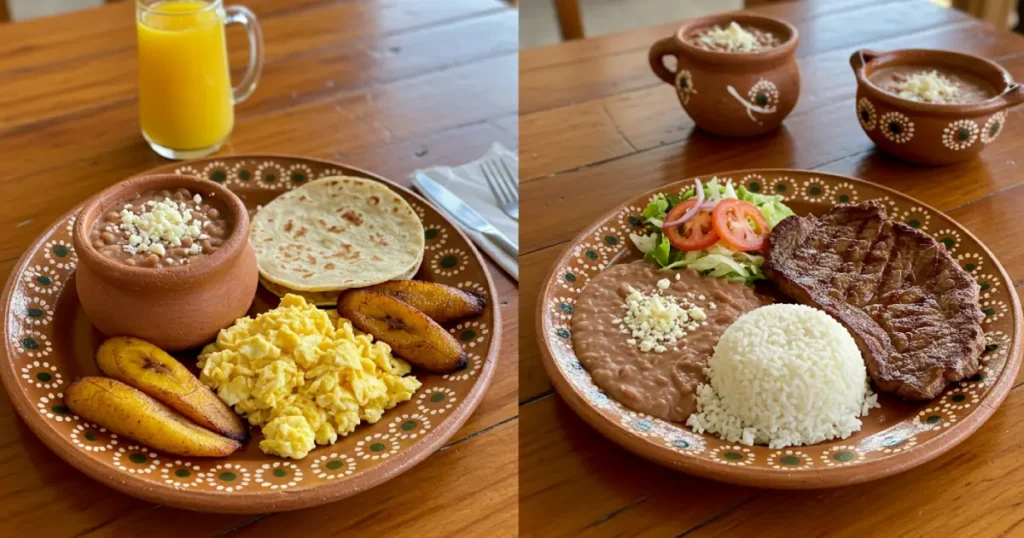
Today, frijoles volteados are an undeniable constant in Guatemalan gastronomy. They are a key component of the typical Guatemalan breakfast, often served alongside eggs (scrambled or fried), fresh cheese (queso fresco), fried plantains (plátanos fritos), and, of course, corn tortillas. This hearty breakfast provides sustained energy for the day.
But their presence doesn't end with the morning meal. Frijoles volteados are a common accompaniment to lunch and dinner as well, served with grilled meats, chicken stews, or as part of a simple yet satisfying meal with rice and tortillas. Their versatility and affordability make them accessible across all socio-economic strata, from humble homes to upscale restaurants. As noted in a study by the Universidad de San Carlos de Guatemala, beans are a basic food for Guatemalans of all social levels, becoming indispensable in the diet, especially for those in lower socio-economic scales, where along with maize, they represent the most consumed food items.
Celebrations and Special Occasions
While an everyday food, frijoles volteados also find their place in celebratory meals and special occasions, often as part of a larger spread of traditional dishes. Their comforting and familiar flavor makes them a welcome addition to any feast. The industrial production of frijoles volteados, reaching thousands of metric tons annually, also points to their widespread and consistent demand within the country.
How to Prepare Authentic Frijoles Volteados: A Step-by-Step Guide
Making frijoles volteados from scratch is a rewarding process that fills your kitchen with an irresistible aroma. While canned versions offer convenience, the depth of flavor achieved from dried beans is unparalleled.
Ingredients You'll Need:
- 1 cup dried black beans, picked over and rinsed
- 6 cups water (for cooking beans)
- 1/2 medium white onion, cut into large chunks (for cooking beans)
- 2 cloves garlic, whole (for cooking beans)
- 1 teaspoon salt (for cooking beans), or to taste
- 2-3 tablespoons lard or vegetable oil
- 1/4 medium white onion, finely chopped (for refrying)
- 1-2 cloves garlic, minced (for refrying)
- Salt to taste (for refrying)
- Reserved bean cooking liquid, as needed
Cooking the Beans to Perfection (from dried):
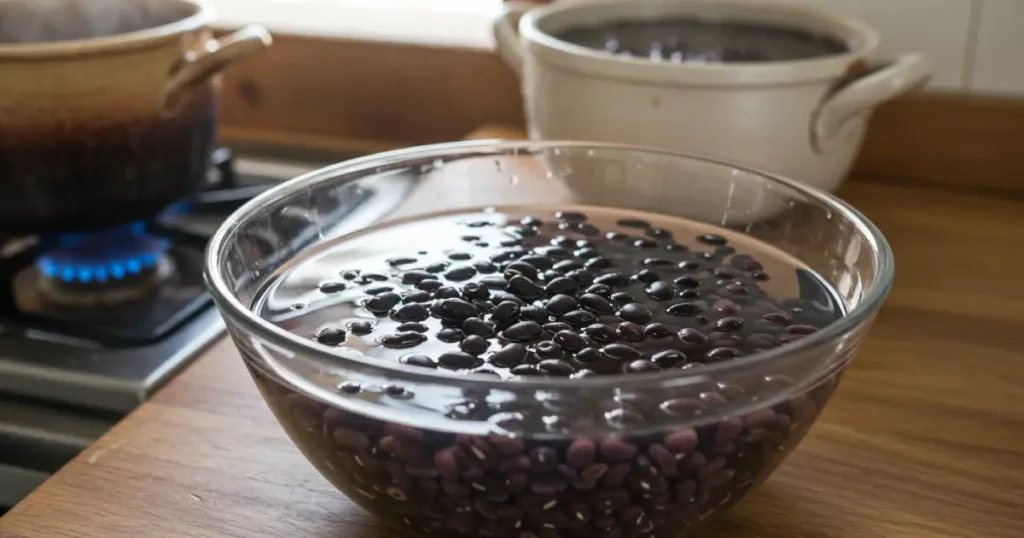
- Soaking (Optional but Recommended): Place the rinsed black beans in a large bowl and cover them with water by at least 2 inches. Let them soak for at least 8 hours or overnight. Soaking helps to reduce cooking time and can make the beans easier to digest. If you're short on time, you can do a "quick soak": bring the beans and water to a boil for 2-3 minutes, then remove from heat, cover, and let stand for 1 hour. Drain and rinse the soaked beans. Note: Some traditional recipes for black beans specifically advise against discarding the soaking water, believing it helps maintain the deep black color. If following this, use the soaking water for cooking.
- Cooking the Beans: In a large pot or Dutch oven, combine the soaked (or unsoaked, if skipping that step) beans, 6 cups of fresh water (or the soaking water if preferred), the chunks of onion, whole garlic cloves, and 1 teaspoon of salt.
- Simmering: Bring the water to a boil over high heat. Once boiling, reduce the heat to low, cover the pot, and let the beans simmer gently. If using unsoaked beans, this can take 2 to 3 hours. If using soaked beans, it might take 1 to 1.5 hours. The beans are done when they are very tender and can be easily mashed with a fork. Add more water during cooking if needed to keep the beans submerged.
- Prepare for Blending: Once tender, remove and discard the large onion chunks and whole garlic cloves from the pot. Do not discard the bean cooking liquid; it's precious!
The "Volteado" Technique:
- Blending the Beans: Carefully transfer the cooked beans with some of their cooking liquid to a blender or food processor. (Alternatively, you can use an immersion blender directly in the pot, ensuring there's enough liquid). Start with about 1 cup of the cooking liquid. Blend until you achieve a very smooth puree. If the mixture is too thick to blend properly, add a little more of the reserved cooking liquid, a tablespoon at a time, until it reaches a thick but pourable consistency, similar to a thick pancake batter. Season with a bit more salt if needed.
- Sautéing Aromatics: In a large, heavy-bottomed skillet or pan (non-stick is helpful here), heat the lard or vegetable oil over medium heat. Add the finely chopped onion and sauté until softened and translucent, about 3-5 minutes. Add the minced garlic and cook for another minute until fragrant, being careful not to burn it.
- Refrying and Thickening: Pour the blended bean puree into the skillet with the sautéed aromatics. Stir well to combine. Now, the crucial part: cook the beans over medium to medium-low heat, stirring constantly and scraping the bottom of the pan with a spatula or wooden spoon to prevent sticking and ensure even cooking.
- Achieving the "Volteado" Consistency: Continue cooking and stirring. The beans will gradually thicken as the excess moisture evaporates. This process can take anywhere from 10 to 30 minutes, depending on how much liquid was in your puree and how thick you want the final product. For true "volteados," you're looking for a consistency where the beans pull away from the sides of the pan as you stir, and if you tilt the pan, the mass of beans might move or "turn over" almost in one piece. They should be thick enough to hold their shape on a spoon. Some describe this as the point where you can draw a line with your spoon through the beans on the pan, and the line holds for a few seconds.
- Taste and Adjust: Taste the frijoles volteados and adjust the salt if necessary.
Tips for the Best Texture and Flavor:
- Don't Rush the Thickening: Patience is key. Stirring constantly prevents scorching and helps develop the characteristic texture.
- Use a Good Pan: A heavy-bottomed or non-stick skillet will make the process easier and prevent sticking.
- Lard for Authenticity: If you're not vegetarian, using lard will give a more traditional and arguably richer flavor.
- Strain for Extra Smoothness (Optional): For an ultra-smooth, velvety texture, some cooks strain the bean puree through a fine-mesh sieve before refrying. This is more common in restaurant preparations.
- Adjusting Consistency: If the beans become too thick too quickly, you can stir in a tablespoon or two of the reserved bean cooking liquid or water. If they are too thin, continue cooking and stirring until they reach the desired thickness.
Regional Variations of Frijoles Volteados in Guatemala
While the core concept of frijoles volteados remains consistent, slight regional nuances can exist, often dictated by locally available complementary ingredients or subtle preferences in seasoning or final consistency. However, black beans are predominantly used for this preparation throughout Guatemala. Some sources note that while black beans are typical for Guatemala, red beans might be more common for refried bean dishes in other Central American nations.
Coastal Influences
In coastal regions, meals might more frequently include seafood, and frijoles volteados could be served as a grounding, familiar side. The specific preparation of the beans themselves doesn't drastically change, but the overall meal composition might differ.
Highland Preferences
In the highlands, where corn and beans are deeply entrenched dietary staples, frijoles volteados are a constant. The preparation here is often very traditional, emphasizing the pure flavor of the beans. The consistency might be preferred slightly thicker, especially in cooler climates where they can be molded and hold their shape well.
It's important to note that "frijoles colados" (strained beans) is another related preparation, particularly known in areas like Yucatan in Mexico but also found in variations in Guatemala. This involves straining the pureed beans to achieve an exceptionally smooth texture, similar to the optional straining step mentioned earlier.
Serving Suggestions: How to Enjoy Frijoles Volteados
The versatility of frijoles volteados is one of their greatest strengths. They can be enjoyed in countless ways:
As a Side Dish
This is their most common role. A generous dollop of frijoles volteados is the perfect partner for:
- Breakfast: With scrambled or fried eggs, fried plantains, queso fresco (fresh cheese) or queso seco (aged, salty cheese), and warm corn tortillas or Guatemalan bread (pan francés).
- Lunch/Dinner: Alongside grilled meats (carne asada), chicken (pollo dorado or stews like Pepián or Jocon), or fish. They also pair beautifully with rice.
As a Main Component
While often a side, frijoles volteados can also be the star:
- Spread on Tortillas: Simply spread on warm corn tortillas, perhaps with a sprinkle of cheese or a dollop of crema (Guatemalan sour cream).
- Filling for Dobladas or Tostadas: Used as a filling for "dobladas" (folded and often lightly fried tortillas) or as a base layer on "tostadas" (crispy fried tortillas) topped with salsa, guacamole, cheese, and other garnishes.
- With Nachos or Chips: As a dip for totopos (tortilla chips).
- In "Shucos": While not the primary filling, a smear of frijoles can sometimes be found in these popular Guatemalan hot dogs.
Perfect Pairings
Certain accompaniments elevate the frijoles volteados experience:
- Tortillas: Freshly made corn tortillas are the quintessential pairing.
- Queso Fresco or Seco: The salty, crumbly cheese offers a wonderful contrast in texture and flavor.
- Crema Guatemalteca: Similar to sour cream but often a bit thinner and tangier, it adds a creamy coolness.
- Avocado or Guacamole: The creaminess of avocado complements the beans beautifully.
- Fried Plantains (Plátanos Fritos): The sweetness of ripe plantains is a classic counterpoint to the savory beans.
- Hot Sauce (Picante): For those who like a bit of heat, a few dashes of Guatemalan hot sauce can add another layer of flavor.
The Nutritional Value of Frijoles Volteados
Black beans, the primary ingredient in frijoles volteados, are a nutritional powerhouse. They are an excellent source of:
- Plant-Based Protein: Making them a vital protein source, especially in vegetarian or largely plant-based diets.
- Dietary Fiber: Both soluble and insoluble fiber, which aids in digestion, helps regulate blood sugar levels, and can contribute to lowering cholesterol. A 1/2 cup serving of black beans can provide 8 grams of fiber.
- Complex Carbohydrates: Providing sustained energy. Black beans have a low glycemic index.
- Micronutrients: Including folate, iron, magnesium, potassium, manganese, phosphorus, and zinc. These minerals are crucial for various bodily functions, including building and maintaining bone structure, producing red blood cells, and supporting heart health.
- Antioxidants: Black beans contain antioxidants like anthocyanins, which help combat inflammation and oxidative stress.
While the refrying process adds fat (from oil or lard), choosing healthier fats and using them in moderation can ensure that frijoles volteados remain a nutritious part of a balanced diet. They are naturally cholesterol-free (if made with vegetable oil).
Frijoles Volteados: More Than Just Beans
To truly understand Guatemalan cuisine is to appreciate the significance of frijoles volteados. They are more than just a simple dish of refried beans; they are a taste of home, a symbol of sustenance, and a thread that connects generations. Their presence on the table is a comforting constant in a rapidly changing world.
The process of making them, from cooking the beans to the careful stirring and thickening, is often a labor of love, passed down through families. The aroma alone can evoke powerful memories and a sense of belonging. Whether enjoyed in a bustling city eatery, a quiet village home, or a festive gathering, frijoles volteados represent the heart and soul of Guatemalan everyday cooking – simple, nourishing, and profoundly satisfying.
Conclusion
Frijoles volteados are a culinary emblem of Guatemala. Their rich, earthy flavor and distinctive smooth, thick texture make them a beloved staple across the nation. From their ancient Mesoamerican roots to their modern-day ubiquity, these "turned" black beans offer a delicious and nutritious insight into Guatemalan culture and its deep connection to the land and its bounty. Whether you're a seasoned traveler familiar with Central American flavors or a curious foodie looking to expand your culinary horizons, exploring the world of frijoles volteados is a journey worth taking. Their comforting simplicity and profound flavor are sure to leave a lasting impression.

Leave a Reply